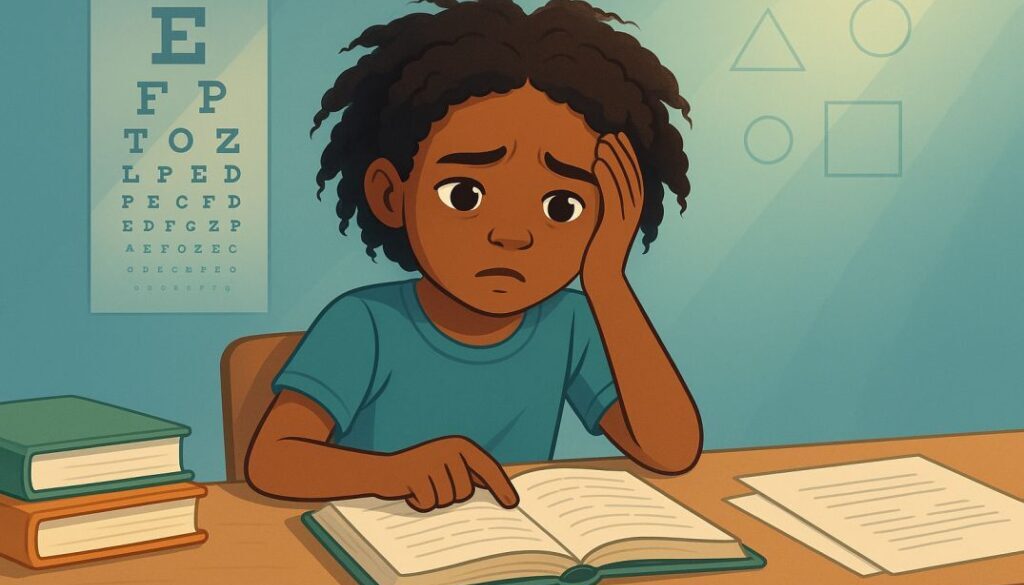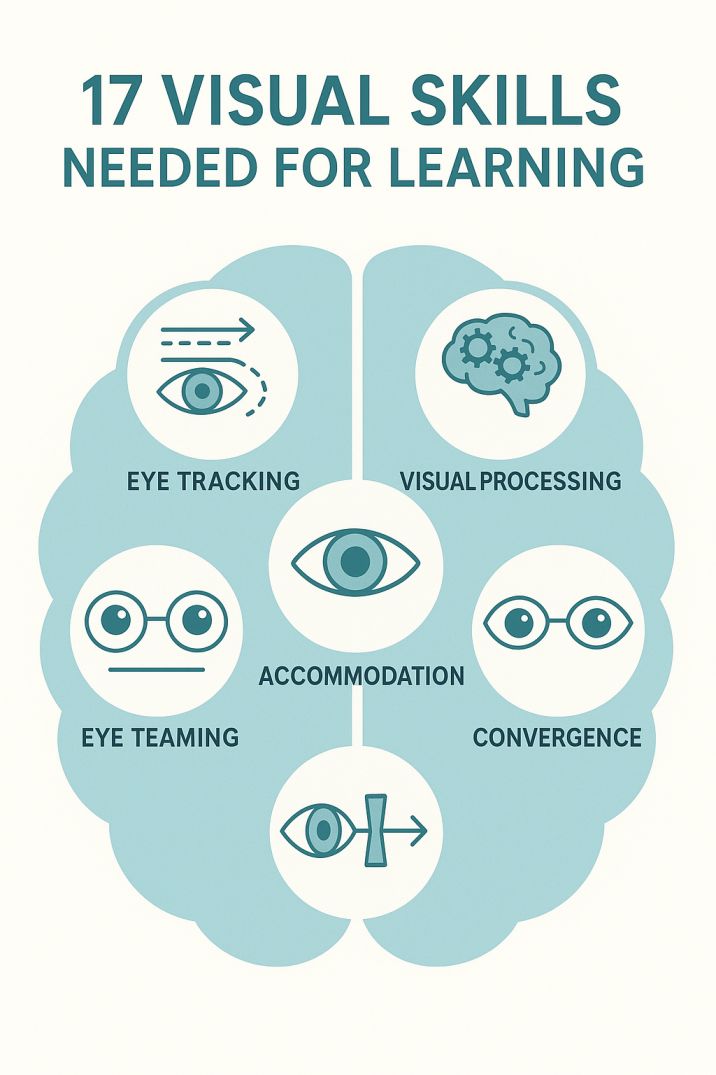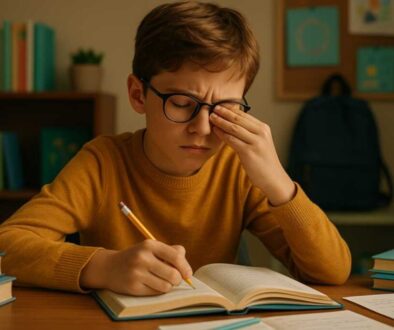Traditional Tutoring Not Working? Try Vision Therapy

Bottom Line Up Front: If your bright child continues to struggle academically despite intensive tutoring, the root cause may be an undiagnosed vision problem, not a learning deficiency. Understanding the dyslexia and vision connection while finding quality vision therapy near me can address these underlying visual skills that traditional education overlooks.
The Hidden Crisis: When Bright Children Can’t Keep Up
You’ve tried everything. Your child tests well on intelligence assessments, shows creativity and problem-solving skills at home, yet struggles tremendously with reading, writing, and classroom focus. After months or even years of traditional tutoring, you’re watching your bright child lose confidence while making minimal academic progress.
You’re not alone, and it’s not your fault.
Research shows 25 percent of children have a significant vision problem that impacts their learning, according to the American Optometric Association (AOA). Up to 80 percent of all learning comes through the visual pathways. Yet most parents never consider that vision could be the missing piece of their child’s academic puzzle.
Why Traditional Tutoring Falls Short
The Fundamental Flaw in Subject-Based Tutoring
Traditional tutoring operates on a flawed assumption: that academic struggles stem from knowledge gaps or cognitive limitations. Many years ago, educators assumed that if you want to help your kids do better in a subject they’re struggling with, you need to get them some tutoring for that subject. However, kids who ONLY got help for English or Math or whatever subject they were “struggling” with kept struggling. Their grades didn’t really change, but they did feel worse about themselves.
When vision problems are the root cause, traditional tutoring becomes an exercise in frustration—both for the child and the tutor. When children have a vision problem, tutoring or learning centers aren’t the answer. Their vision must be properly treated to turn them into better learners.
The Hidden Visual Skills Crisis
Seeing clearly (“20/20”) is just one of 17 visual skills critical to academic success. Vision screenings in school and at the pediatrician’s office typically test only distance vision. Your child may pass every eye exam while struggling with critical visual processing skills that directly impact learning.
These overlooked visual skills include:
- Eye tracking (following lines of text smoothly)
- Eye teaming (coordinating both eyes together)
- Visual processing (making sense of what the eyes see)
- Accommodation (focusing clearly at different distances)
- Convergence (aiming both eyes at near objects)
The Vision-Learning Connection: What Science Reveals
Recent Research Findings
Recent studies demonstrate the profound connection between vision problems and learning difficulties:
A comprehensive 2018 study of 94 children with learning disabilities found that binocular vision anomalies were present in 59 children (62.8%), with accommodative infacility found in 31 children (68%), followed by convergence insufficiency in 11 children (25%).
Research published in 2017 in the Journal of Ophthalmic and Visual Research found that among children with convergence insufficiency, vision therapy achieved an 87.5% success rate, with significant improvements in near point of convergence and positive fusional vergence.
A 2024 systematic review published in the Journal of Ophthalmology confirmed that neural changes occur in patients with convergence insufficiency after vision therapy, characterized by alterations in brain activity within several areas, including the frontal, temporal, parietal, and occipital lobes and the cerebellum.
Convergence insufficiency affects approximately 5% to 13% of school-age children based on the most recent literature, with research from 2024 showing that approximately 20% of children tested showed 2-3 signs of CI. It is therefore possible, that multiple children in every classroom may be struggling with this condition!
The Convergence Insufficiency Connection
Studies confirm that office-based vergence/accommodative therapy is effective for improving convergence in children with symptomatic convergence insufficiency, with neural changes occurring in several brain areas including the frontal, temporal, parietal, and occipital lobes and the cerebellum.
Understanding Dyslexia and Vision: Separating Fact from Fiction
The Controversial Dyslexia and Vision Connection
The relationship between dyslexia and vision remains one of the most debated topics in education and optometry. While mainstream medical organizations maintain that dyslexia is a problem with language, not with vision, and that scientific evidence does not support vision therapy as a treatment for dyslexia, many parents and vision therapy practitioners report different experiences when addressing the dyslexia and vision overlap.
When Vision Problems Masquerade as Dyslexia
Many people mistakenly believe that dyslexia is a vision problem; it is a brain processing problem that cannot be treated with vision therapy. However, undiagnosed visual problems are commonly misdiagnosed as dyslexia, creating confusion about the true dyslexia and vision relationship.
It’s often impossible for a teacher or parent to know whether a child has a vision problem or dyslexia because both conditions can manifest in similar ways. The dyslexia and vision symptom overlap includes:
- Difficulty tracking across lines of text
- Skipping words or lines while reading
- Poor reading comprehension despite adequate decoding
- Fatigue during reading tasks
- Avoidance of close work
The “Stealth Dyslexia” Phenomenon
In our practice we often see children who are struggling academically due to difficulties that are clearly dyslexia-related, yet who show age-appropriate – and in many cases even superior – reading skills. Because of their apparently strong reading skills, most of these children have never been identified as dyslexic.
This “stealth dyslexia” is particularly common among gifted children who use superior language skills to compensate for underlying visual processing deficits.
Red Flags: When to Suspect Vision Problems
Academic Warning Signs
Reading and Writing Issues:
- Skips lines or loses place while reading
- Uses finger or ruler to track text
- Complains of words “moving” on the page
- Poor handwriting despite adequate fine motor skills
- Huge gap between oral and written expression
Attention and Behavior Symptoms:
- Short attention span for visual tasks
- Frequent rubbing of eyes
- Tilts head while reading or writing
- Covers or closes one eye during close work
- Avoids homework or reading
Physical Complaints:
- Headaches after reading or homework
- Eye strain or fatigue
- Double vision or blurred vision
- Motion sickness or car sickness
The Tutoring Red Flags
If your child exhibits these patterns despite tutoring:
- Intelligence shows in verbal tasks but not written work
- Can pronounce words and run through sentences, but lacks comprehension – may end up learning to read but never reading to learn
- Performance varies dramatically between subjects
- Seems “lazy” or unmotivated despite obvious intelligence
- Multiple failed interventions with traditional approaches
Vision Therapy Near Me: Finding the Right Solution
What Is Vision Therapy?
Vision therapy is an attempt to develop or improve visual skills and abilities; improve visual comfort, ease, and how well the eyes work; and change visual processing or understanding of visual information. A vision therapy program is usually made up of monitored in-office and at home eye exercises that are done over weeks to months.
The Evidence for Vision Therapy
A large body of compelling research studies has demonstrated that vision therapy is cost effective and has a high success rate compared to other treatments in the remediation of vision-related learning disorders. Many of these studies show that the highest success rates occur when office therapy is combined with home vision therapy.
Success Rates: A multi-site randomized clinical trial funded by the National Eye Institute called the Convergence Insufficiency Treatment Trial showed that 75% of all children achieved either full correction of their vision or saw marked improvements within 12 weeks.
Finding Quality Vision Therapy Near Me
When searching for “vision therapy near me,” it’s crucial to find practitioners who understand both vision disorders and learning challenges. The best vision therapy near me providers will offer:
Qualified Practitioners:
- Developmental or behavioral optometrists
- Board certification from the College of Optometrists in Vision Development (COVD)
- Experience with learning-related vision problems
- Comprehensive vision evaluations beyond standard eye exams
Red Flags to Avoid:
- Practitioners who claim vision therapy “cures” dyslexia
- One-size-fits-all approaches
- Lack of proper diagnostic testing
- Unrealistic promises or timelines
Cook Vision Therapy Center: A Model Approach
Based on our analysis of successful vision therapy practices, effective treatment centers share common characteristics:
Specialized Expertise: Exclusive focus on vision therapy rather than general eye care Comprehensive Assessment: Testing all 17 visual skills, not just acuity Individualized Treatment: Customized programs based on specific deficits Family-Centered Care: Understanding the entire family’s journey through vision challenges Evidence-Based Protocols: Following established research guidelines
The Treatment Journey: What to Expect
Initial Comprehensive Assessment
A proper vision therapy evaluation includes:
- Complete medical and developmental history
- Tests for all binocular vision functions
- Assessment of visual processing skills
- Evaluation of eye movement abilities
- Analysis of accommodation and convergence
Typical Treatment Timeline
Weeks 1-4: Foundation building and basic skill development Weeks 5-12: Progressive skill enhancement and integration Weeks 13-20: Advanced training and real-world application Follow-up: Maintenance and monitoring
Some gains can be seen within a few weeks, but it can take up to 6 months to realize significant results. Vision therapy includes in-office and home exercises, visual aids, or eyeglasses and involves close monitoring and follow-up appointments.
Success Stories: Real Results from Vision Therapy
Testimonials from Families
“8 weeks of vision therapy has done more than all 3 years of tutoring.” – Parent of 8-year-old
“After years of trying other band aid approaches to clarifying my son’s learning issues, we have found the root of the problem.” – Parent testimonial
“This year, the school pulled us aside to let us know that there is possibility he may have to be held back because of his reading level, even though he had been with a tutor for the last two years… in four months of using [vision therapy], his improvement has been so drastic that the school called us and wanting to know what we had done.”
Measurable Outcomes
Research demonstrates consistent improvements in:
- Reading speed and accuracy
- Attention span and focus
- Academic performance across subjects
- Self-confidence and willingness to engage in visual tasks
- Reduced symptoms of eye strain and fatigue
Taking Action: Next Steps for Parents
Immediate Steps
- Schedule a Comprehensive Vision Evaluation: Find a developmental optometrist who tests all visual skills
- Document Current Struggles: Keep a record of academic difficulties and tutoring attempts
- Communicate with School: Share findings with teachers and educational team
- Research Local Providers: Use resources like COVD.org to find qualified practitioners
Working with Your Current Tutor
If vision problems are identified:
- Share findings with current educational team
- Modify tutoring approaches to accommodate visual needs
- Consider pausing intensive tutoring during initial vision therapy
- Plan for gradual reintegration of academic support
Long-term Considerations
Educational Accommodations: Work with schools to implement appropriate supports during treatment Home Environment: Optimize lighting, reading materials, and workspace setup Progress Monitoring: Regular check-ins with both vision therapist and educational team Family Support: Understanding that this journey requires patience and persistence
The Cost-Benefit Analysis
Financial Investment vs. Long-term Impact
While vision therapy requires an upfront investment, consider the long-term costs of:
- Years of ineffective tutoring
- Academic struggles and potential grade retention
- Reduced self-esteem and confidence
- Limited career and educational opportunities
- Ongoing learning support needs
The global therapeutic market for attention-deficit hyperactivity disorder (ADHD) is expected to reach $25 billion by 2024. The National Center for Learning Disabilities reports that the US government puts $11.5 billion toward funding programs every year. But those programs rarely include any form of vision therapy.
Insurance and Coverage Options
Many vision therapy treatments may be covered under:
- Vision insurance plans
- Medical insurance for diagnosed conditions
- Health Savings Account (HSA) funds
- Flexible Spending Account (FSA) funds
Resources and Citations
The following peer-reviewed studies and authoritative sources were used to support the evidence-based information in this article:
-
Efficacy of vision therapy in children with learning disability and associated binocular vision anomalies – PMC5777927 (2018)
https://pmc.ncbi.nlm.nih.gov/articles/PMC5777927/
This comprehensive study of 94 children with learning disabilities found 62.8% prevalence of binocular vision anomalies, providing key statistics on the vision-learning connection. -
Neural Changes after Vision Therapy in Convergence Insufficiency: A Systematic Review – Journal of Ophthalmology (2024)
https://pmc.ncbi.nlm.nih.gov/articles/PMC11303052/
This recent systematic review demonstrates measurable brain changes following vision therapy treatment, supporting the neurological basis of vision therapy effectiveness. -
Effectiveness of Vision Therapy in School Children with Symptomatic Convergence Insufficiency – Journal of Ophthalmic and Visual Research (2017)
https://www.ncbi.nlm.nih.gov/pmc/articles/PMC5423373/
Korean study showing 87.5% success rate for vision therapy in children with convergence insufficiency, providing evidence for treatment effectiveness. -
American Optometric Association Policy Statement on Vision, Learning and Dyslexia
https://pubmed.ncbi.nlm.nih.gov/9170793/
Joint organizational policy statement establishing that vision problems can interfere with learning and outlining professional guidelines for intervention.
Conclusion: Transforming Your Child’s Future
The journey from academic struggle to success often requires looking beyond traditional educational approaches. When a child is starting to read and pronounce the words in 1st or 2nd grade, if they have a vision problem, their learning will be slower than other children and unfortunately, the issue generally won’t go away on its own.
Your bright child deserves every opportunity to succeed. If the vision problem is addressed early, the child can enjoy their early school years with fully developed visual skills and not have to face these challenges at an older age.
Don’t let another year pass watching your child struggle. Take the first step by scheduling a comprehensive vision evaluation with a qualified developmental optometrist in your area. Your child’s academic success—and confidence—may depend on it.
FAQs
-
Traditional tutoring may miss vision or processing issues. If a child can’t see or track words well, academic support alone won’t resolve reading struggles



